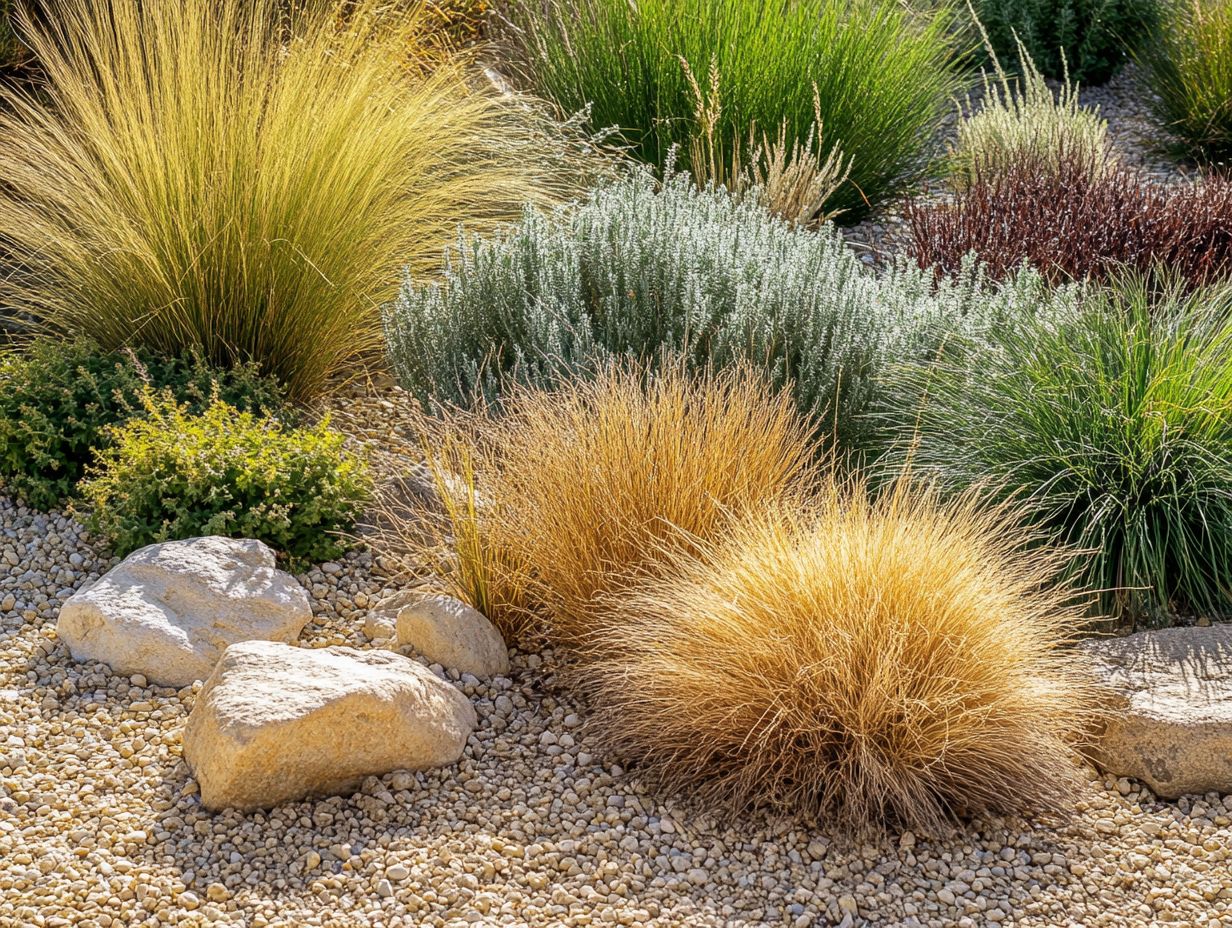5 Best Drought-Tolerant Grasses for Yards
If you’re weary of wrestling with a thirsty lawn and seek to conserve water while nurturing a vibrant yard, this article is for you!
We delve into five of the finest drought-tolerant grasses such as Buffalo and Bermuda grass that flourish even in arid conditions.
You will discover what makes these grasses resilient, how to select the ideal variety for your landscape, and the myriad benefits they provide.
Prepare yourself for expert tips on preparation and maintenance, ensuring your drought-tolerant grass thrives beautifully!
Contents
- Key Takeaways:
- 1. Buffalo Grass
- 2. Bermuda Grass
- 3. Zoysia Grass
- 4. Tall Fescue
- 5. St. Augustine Grass
- Why Choose Drought-Tolerant Grass?
- How to Choose the Right Drought-Tolerant Grass for Your Yard?
- What Are the Benefits of Using Drought-Tolerant Grass?
- What Are the Maintenance Requirements for Drought-Tolerant Grass?
- How Can You Prepare Your Yard for Drought-Tolerant Grass?
- What Are Some Tips for Successfully Growing Drought-Tolerant Grass?
- Frequently Asked Questions
Key Takeaways:

- Choose Buffalo Grass for a low-maintenance option that withstands drought and high temperatures.
- Bermuda Grass is popular for thriving in hot and dry climates, with deep roots that enhance drought resistance.
- Zoysia Grass is slow-growing and dense, requiring less water and maintenance, making it ideal for drought-prone areas.
Embrace these grasses for a beautiful, low-water lawn!
1. Buffalo Grass
Buffalo grass is a resilient grass that grows well in warm weather, perfectly suited for regions like Texas where water scarcity poses a challenge. It s no wonder it s a favored option for drought-tolerant lawns.
This remarkable grass also exhibits impressive drought resistance. It flourishes in arid conditions while demanding significantly less water than many traditional lawn grasses, similar to the top 5 succulents for drought-prone areas.
Its adaptability to a variety of soil types, from sandy to clay, allows it to thrive. Looking for a sustainable landscaping solution? Buffalo grass could be your answer!
2. Bermuda Grass
Bermuda grass is your go-to choice if you’re looking for a resilient option in warm climates. It thrives in areas with high temperatures and low water availability, making it ideal for homeowners who want to maintain a lush green lawn.
This hardy species showcases rapid growth and establishes itself quickly in well-drained, sandy soils. It flourishes under direct sunlight and warmer temperatures.
With its impressive water efficiency, it s an appealing choice for those who prioritize conservation and sustainability.
Its deep root system enhances drought resistance and contributes to a lush, dense turf quality. This creates a vibrant aesthetic that few other species can match, making Bermuda grass a top choice for eco-conscious homeowners.
3. Zoysia Grass
Zoysia grass is an exceptional choice for those seeking a drought-resistant lawn, particularly in transitional zones. Its remarkable ability to endure heat and drought while delivering a dense, carpet-like turf elevates any landscape.
What truly sets Zoysia apart are its unique growth habits. It may grow at a slower pace in cooler conditions, but once temperatures rise, it spreads through both stolons (above-ground runners) and rhizomes (below-ground runners).
This adaptability enables it to flourish in a range of soil types, retaining a vibrant appearance even in less-than-ideal conditions. Zoysia impresses with its low maintenance needs, requiring less frequent mowing and minimal fertilizer.
Its robust nature allows it to recover better from wear and tear, ensuring a lush and healthy lawn that stands resilient through all seasons.
4. Tall Fescue

Tall fescue is your go-to cool-season grass. It thrives in a variety of climates and is ideal for homeowners facing fluctuating temperatures. With impressive drought resistance and deep root systems, this grass significantly reduces water needs.
This grass type also adapts remarkably well to different soil conditions, from sandy loams to clay-heavy terrains. It flourishes even when the going gets tough. Its deep root system boosts drought resilience and plays a vital role in nutrient absorption, enabling it to coexist harmoniously with other species in mixed lawns.
As a result, you’ll find that tall fescue can create a lush, diverse landscape that conserves water and enhances biodiversity. It s a practical yet visually appealing option for any lawn enthusiast.
5. St. Augustine Grass
St. Augustine grass is a favored option in Southern California. It is admired for its lush look and impressive heat tolerance. However, its drought resistance can be inconsistent, requiring diligent management, especially with increasing water restrictions and climate challenges on the horizon.
To ensure optimal growth, you must provide consistent irrigation, particularly during scorching summer months. Without prompt watering, your lawn could quickly develop unsightly brown patches. This grass thrives in warm climates but requires regular upkeep, including proper mowing and fertilization.
While it delivers a stunning, dense lawn and boasts greater shade tolerance than many alternatives, its high water needs may not make it the ideal choice for every homeowner. When considering options, especially in the context of drought-tolerant species, weigh these factors carefully. Understanding these nuances will empower you to make informed decisions for your landscaping needs.
Why Choose Drought-Tolerant Grass?
Drought-tolerant grasses have unique traits that enable them to flourish in arid conditions. They have deep root systems, efficient water usage, and can adapt to diverse soil types and climates. Additionally, incorporating drought-resistant flowers is vital for sustainable landscaping in water-scarce regions.
These grasses develop extensive root networks that delve deep into the soil, tapping into moisture far below the surface. Their leaf structure is a marvel; narrower leaves reduce water loss through evaporation while still allowing for effective photosynthesis. They have impressive water retention capabilities, enabling them to hold onto moisture longer, even during dry spells.
Collectively, these characteristics ensure survival in tough environments and lead to significant reductions in overall water consumption. This promotes healthier ecosystems and fosters sustainable gardening practices, allowing you to create a thriving landscape that respects conservation needs.
How to Choose the Right Drought-Tolerant Grass for Your Yard?
Choosing the right drought-tolerant grass for your yard requires thoughtful consideration of your local climate, soil type, and specific water needs. For inspiration, check out these must-visit drought-tolerant landscapes. This ensures that the grass you select will thrive even with limited moisture.
Understanding the unique characteristics of your environment is crucial, as different grass types show varying levels of resilience to drought. For instance, if you reside in a warm climate zone with sandy soil, Bermuda grass might be your best bet due to its deep root system and heat tolerance. Conversely, if you’re in a cooler region, you could find success with fescue varieties, celebrated for their adaptability and shade tolerance. Additionally, consider exploring drought-resistant ground covers for your yard to enhance your landscape’s resilience.
Assessing how much sunlight your yard receives whether basking in full sun or enjoying partial shade allows you to choose species that can efficiently harness available sunlight while conserving water. By aligning these elements, you’ll achieve a lush and sustainable lawn that thrives effortlessly.
What Are the Benefits of Using Drought-Tolerant Grass?

Embracing drought-tolerant grass promotes water conservation and lightens your maintenance load. Choosing the best ornamental grasses for dry landscapes cultivates a healthier ecosystem and results in vibrant turf that requires less frequent irrigation.
The benefits are numerous. You’ll notice a significant drop in your water bills, which is especially advantageous in areas facing water scarcity. The reduced mowing frequency will also save you time and energy, making lawn care a breeze.
These grasses demand fewer chemical treatments, which means less impact on local waterways and wildlife. By nurturing a lush yet low-maintenance landscape, you ll create a sanctuary for various birds and beneficial insects, while supporting biodiversity and enjoying a beautiful green space.
What Are the Maintenance Requirements for Drought-Tolerant Grass?
Maintaining drought-tolerant grass requires understanding its specific needs regarding irrigation, soil health, and pest management. This ensures that the grass thrives even with limited water.
Establish an optimal watering routine that mimics natural rainfall patterns. This encourages deep root growth, allowing your grass to access moisture during dry spells.
Incorporating organic soil amendments can significantly boost nutrient retention, supporting robust growth without excessive watering. Regularly monitor your grass for pests and diseases to identify issues early.
Employing integrated pest management strategies means using natural predators or targeted treatments when necessary. These practices collectively cultivate a thriving, sustainable landscape that conserves water efficiently.
How Can You Prepare Your Yard for Drought-Tolerant Grass?
Preparing your yard for drought-tolerant grass requires careful planning and foundational work. Start by assessing your soil health and setting up proper irrigation systems.
Select the ideal grass species that aligns with your local climate. Begin with a soil test to gauge nutrient levels and pH balance. This step will guide you in making necessary amendments, like incorporating organic matter for improved soil structure and water retention.
Create an efficient irrigation strategy that minimizes water waste while ensuring your new grass receives enough moisture during its establishment phase. When planting, consider the best season for your chosen variety spring or early fall is typically optimal.
By following these guidelines and exercising patience during the growth phase, your transition to a sustainable, drought-tolerant landscape will be successful and rewarding.
What Are Some Tips for Successfully Growing Drought-Tolerant Grass?
Successfully nurturing drought-tolerant grass depends on effective water management practices, understanding local climate nuances, and implementing proper maintenance techniques.
Focus on a well-planned watering schedule to enhance the grass’s resistance to dry conditions. Adjust your seasonal care routines by mowing less frequently and allowing the grass to grow taller during hot months for natural shade.
Enriching the soil with organic matter improves water retention and helps the grass thrive with minimal rainfall. Consider environmental factors like sun exposure and soil type to cultivate a resilient lawn that withstands drought.
Frequently Asked Questions

- What is drought-tolerant grass?
- How much water do these grasses need?
- Can I mix drought-tolerant grass with other types?
- What is the best time to plant drought-tolerant grass?
Transform your lawn into a vibrant oasis with drought-tolerant grass! Learn how to create a drought-resistant lawn and start your gardening journey today.
What are the 5 best drought-tolerant grasses for yards?
Bermuda grass, Zoysia grass, Buffalo grass, Tall Fescue, and St. Augustine grass are top choices for drought-resistant landscaping.
What makes these grasses drought-tolerant?
These grasses grow deep roots that reach water stored deep in the soil. This helps them resist dry conditions.
How do I know which grass is best for my yard?
The best grass for your yard depends on your climate, soil type, and sunlight. A local lawn care expert can help you choose the right one.
Do these grasses require special care?
Even though these grasses can survive with less water, they still need care to stay healthy.
Regular watering, fertilizing, and proper mowing are essential.
Can I mix these grasses in my yard?
Mixing different grass types isn’t recommended. Choose one drought-tolerant grass and plant it throughout your yard for the best results.
Are these grasses suitable for all regions?
While these grasses handle drought well, they may not thrive in every region. To enhance your yard, consider looking into 5 drought-resistant shrubs and make sure to research your area’s climate and soil before making a choice!






